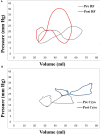Left Atrial Function Post Radiofrequency and Cryoballoon Ablation Assessed by Volume-Pressure Loops
- PMID: 35355975
- PMCID: PMC8959489
- DOI: 10.3389/fcvm.2022.830055
Left Atrial Function Post Radiofrequency and Cryoballoon Ablation Assessed by Volume-Pressure Loops
Abstract
Background: Left atrial (LA) function is linked to atrial fibrillation (AF) pathogenesis. AF catheter ablation decreases disease burden with potentially favorable effects on cardiac function. Atrial volume-pressure loops can optimally assess the LA function.
Objective: To investigate changes in LA function by volume-pressure loops after paroxysmal AF ablation and explored potential differences between the radiofrequency and cryoballoon ablation.
Methods: We analyzed 44 patients undergoing paroxysmal AF ablation from 2 centers, 22 treated with radiofrequency and 22 with cryoablation. Pre- and post-procedure, all patients underwent a real-time three-dimensional transthoracic ECG to evaluate LA volume, while simultaneously recording LA pressure following transseptal puncture. Volume-pressure loops pre- and post-procedure were created by paired data. Areas of A-loop (LA booster pump function) and V-loop (LA reservoir function), and the stiffness constant determining the slope of the exponential curve during LA filling were calculated.
Results: Average LA pressure, A-wave amplitude, and V-wave amplitude were increased post-procedurally (p < 0.001). Overall, A-loop area decreased (p = 0.001) and V-loop area tended to increase (p = 0.07). The change in both A-loop and V-loop areas was similar between radiofrequency- and cryoballoon-treated patients (p = 0.18 and p = 0.52, respectively). However, compared with cryoballoon-treated patients, radiofrequency-treated patients had higher increase in the stiffness constant (b = 0.059; 95% CI: 0.022-0.096; p = 0.006).
Conclusion: AF catheter ablation by the radiofrequency or cryoballoon is associated with the decrease of the booster pump function and increase of the reservoir function. Moreover, there is a post-procedural increase of LA pressure which is associated with an acute increase in LA stiffness in radiofrequency ablation, but not in cryoablation.
Keywords: atrial fibrillation; catheter ablation—atrial fibrillation; left atrium; real-time three-dimensional echocardiography; volume pressure loops.
Copyright © 2022 Karanasos, Tyrovolas, Tsiachris, Efremidis, Kordalis, Karmpalioti, Prappa, Karagiannis, Aggeli, Gatzoulis, Tousoulis, Tsioufis and Toutouzas.
Conflict of interest statement
The authors declare that the research was conducted in the absence of any commercial or financial relationships that could be construed as a potential conflict of interest.
Figures



References
-
- Hindricks G, Potpara T, Dagres N, Arbelo E, Bax JJ, Blomstrom-Lundqvist C, et al. . 2020 ESC Guidelines for the diagnosis and management of atrial fibrillation developed in collaboration with the European Association of Cardio-Thoracic Surgery (EACTS). Eur Heart J. (2021) 42:373–98. 10.1093/eurheartj/ehaa612 - DOI - PubMed
-
- Park J, Joung B, Uhm JS, Young Shim C, Hwang C, Hyoung Lee M, et al. . High left atrial pressures are associated with advanced electroanatomical remodeling of left atrium and independent predictors for clinical recurrence of atrial fibrillation after catheter ablation. Heart rhythm. (2014) 11:953–60. 10.1016/j.hrthm.2014.03.009 - DOI - PubMed
-
- Jahnke C, Fischer J, Gerds-Li JH, Gebker R, Manka R, Fleck E, et al. . Serial monitoring of reverse left-atrial remodeling after pulmonary vein isolation in patients with atrial fibrillation: a magnetic resonance imaging study. Int J Cardiol. (2011) 153:42–6. 10.1016/j.ijcard.2010.08.034 - DOI - PubMed
LinkOut - more resources
Full Text Sources

